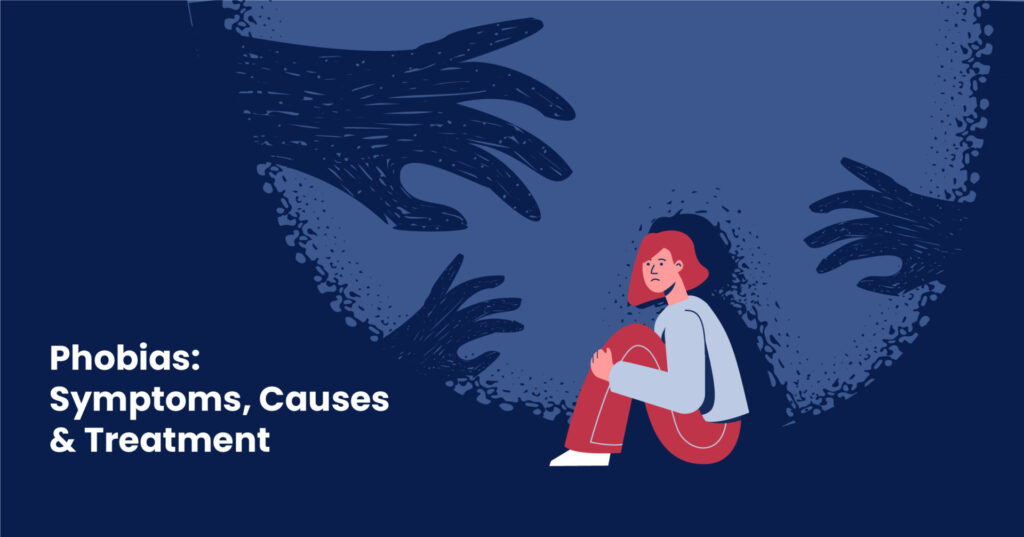What is Phobia?
According to the American Psychological Association,
Phobia is a persistent and irrational fear of a specific situation, object or activity which is either strenuously avoided or endured with marked distress.
Phobias fall under the category of anxiety disorders. The source of the phobia can cause a deep fear and panic when the individual encounters it. The impact of the phobia can range from mere annoyance to disabling the individual’s movements. People with phobias know that the fear is irrational but they do not know how to overcome phobias.
Every human being is born with two phobias: fear of falling and fear of loud noises. The other phobias are categorised into three types: agoraphobia, social phobia and specific phobias.
Agoraphobia is the fear of open spaces from which there is no safe escape. People with agoraphobias are afraid of stepping outside their homes into crowds. They are even likely to have panic attacks if they step outdoors. Due to which they prefer staying indoors which eventually hampers their social life.
Social phobia is also known as social anxiety disorder. It is the extreme worry of being judged and embarrassed in social situations. Individuals with social phobia experience difficulty with even the simple tasks of ordering at a restaurant or calling to book an appointment. Therefore, they make sure to avoid social situations.
Specific phobia is the fear of a specific object such as snakes, clowns, insects, aeroplanes, vomiting, thunderstorms, etc. Each specific phobia has its own psychological term; like zoophobia (fear of animals), tonitrophobia (fear of thunderstorms), ophidiophobia (fear of snakes), nyctophobia (fear of the dark) and many more.
Symptoms of Phobia
Phobia symptoms can range from mild worry to full blown panic or anxiety attacks. The symptoms are in two forms, namely physical symptoms and emotional symptoms.
Physical symptoms of phobia include:
- Increased heartbeat
- Difficulty breathing
- Shivering
- Sweating
- Feeling nauseous
- Feeling dizzy
- Hot or cold flashes
- Dry mouth
- Fumbling or inability to speak
- Inability to move own muscles
Emotional symptoms of phobia include:
- Overwhelming panic
- Desperation to escape
- Depersonalization
- Overthinking negative scenarios
- Sense of losing control over own body
The presence of the above symptoms is directly proportional to the closeness or quantity of the root of the phobia.
Causes of Phobia
The possible causes of phobia include:
Previous Experiences
Past incidences or traumas may be the cause of the phobia. If one has experienced turbulence during a flight as a child or adult, they may anticipate the same situation thereon and be afraid of flying for the rest of their lives.
Learned/Taught Response
Often parents, guardians or teachers repetitively portray a certain thing as harmful in order to protect the child. Unfortunately, the child associates that thing with danger for the rest of their lives hence carrying a phobia of it. If the mother teaches the child that knives are extremely dangerous, the child grows up to avoid any object similar to a knife even in adulthood.
Some phobias are even learned, watching an adult being scared of anything, children learn that the thing is to be avoided always. If they see an elder refusing to sit on or ride a bike, the child learns that bikes are harmful and should not be ridden. Hence, irrespective of their own experiences, the child refuses to learn riding the bike even as an adult.
Genetics
Research suggests that some phobias run in the genes. If either of the parents or grandparents are afraid of the dark, the children may also be afraid of the dark. There have also been studies which suggest that twins who were brought up separately have reported similar phobias.
Cultural Influence
Some cultures in general have inculcated certain fears into the community. In the case of some individuals those fears are deep rooted and lead to extreme phobias.
What Is The Best Treatment for Phobia?
Phobias can and have been treated. The treatment options include self help techniques, therapy and medication. The severity will determine what is the best treatment for the phobia.
Exposure Therapy
Exposure therapy is the first approach used in treating phobia. It exposes the individual to their fear.This exposure can be done gradually (systematic desensitisation), in person (in vivo exposure), through virtual reality (virtual exposure) or all at once (flooding).
During the exposure, the individual is also taught to practice relaxation techniques to help deal with the symptoms.
Cognitive Behavioural Therapy (CBT)
CBT being one of the most common treatments used for phobias.It focuses on identifying and changing the negative thoughts, beliefs and reactions towards the feared object, person or situation. The negative thoughts are turned into positive thoughts.
Eye Movement Desensitisation and Reprocessing (EMDR)
EMDR includes rhythmic eye movements to help one process and heal from past trauma. It is generally used for treating Post Traumatic Stress Disorder (PTSD). The relevance with phobia being, the encounter with the fear object, person or situation often leaves a traumatic memory behind which can be addressed through EMDR.
Medications
Combinations of antidepressants, beta blockers and anti-anxiety medications are used to control the physical and emotional phobia symptoms.
Medications are one of the last resorts and are prescribed in extreme cases.
Read more :





